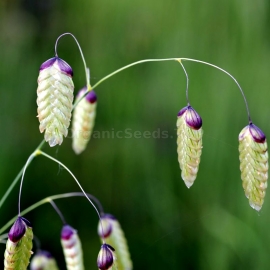







Quaking Grass Organic Seeds (Briza maxima)
1.39 €
Ornamental Grass Briza maxima 'The Greater Quaking Grass' has blue green leaves and flower heads that hang like scaly heart shaped lockets that are tinged with pink from late spring to mid summer.
-
Quaking Grass / Briza maxima
Ornamental Grass Briza maxima 'The Greater Quaking Grass' has blue green leaves and flower heads that hang like scaly heart shaped lockets that are tinged with pink from late spring to mid summer.
This annual Briza prefers richer soil than most grasses and will tolerate semi shade well. Flowering in 10 to 12 weeks from spring sowing, they are very easy to grow to perfection.
Briza maxima has graceful, pendant, nodding heads of oval-shaped, pearly-white seedheads. They make a wonderful cut flower adding elegance and feeling to summer and winter decorations. When first open, the seed heads are green but gradually take on golden shades as summer progresses and become almost animated when touched by a gentle summer breeze.
Sowing
Sow in April-May and/or late August-September. Briza are best sown directly where they are to flower in spring. Grow in sun and in well drained soil. Sow 6mm (¼in) deep in rows 30cm (12in) apart in well cultivated soil which has been raked to a fine tilth. Germination is occasionally slow, so be patient! Thin out the seedlings to 23cm (9in) apart. Replant the seedlings that have been removed.
Cultivation
Feed in spring like ordinary perennials, with a single dressing of a general fertiliser. Even without an annual feed, most grasses will put on a first-rate show. The more nitrogen grasses receive the greener and further they'll grow. This spreading habit is fine in a field, but in a garden they may become too lush and the flower quality may suffer.
The finely textured blades form dense, long-lived evergreen clumps, and forgivingly put up with winds, drought and salt spray. Collect the seed before it disperses to use the following year. Once the plant is established, divide in March to April. It is relatively easy to propagate by division. Do this in spring, not autumn, as some newly divided plants may rot before they've developed a good root system.
Drying
Briza can be used as a cut flower, it will last 10 to 14 days in a vase. It can also be dried and makes interesting focal or secondary flowers in dried arrangements. It is particularly useful at Christmas when the stems and seedheads can be sprayed silver, gold etc.
To dry, gather when the heads have changed colour but before they start to break up, cut the flower at the height of bloom and hang upside down in a cool, dark place to dry. If dried correctly they will hold their colour well.
Plant Uses
Architectural, Cottage/Informal Garden, Drought Resistant, Flower Arranging, Flowers Borders and Beds, Low Maintenance or Mediterranean.
Origin
Briza is a genus of annual and perennial grasses in the family Poaceae, comprising of around twelve species. It is native to north temperate regions. The commonest, Briza media is a delightful little plant usually of limestone or chalky areas. Widespread in Britain except for northern Scotland, it is found in the wild on chalk, grasslands and meadows. It grows freely in damp areas of the fens in East Anglia.
Briza maxima has with larger flower heads, is the much less common Mediterranean immigrant and likely garden escape. It has successfully escaped into the countryside in the south of England but becomes significantly scarcer as you go north. There are few records in Scotland or Ireland.
